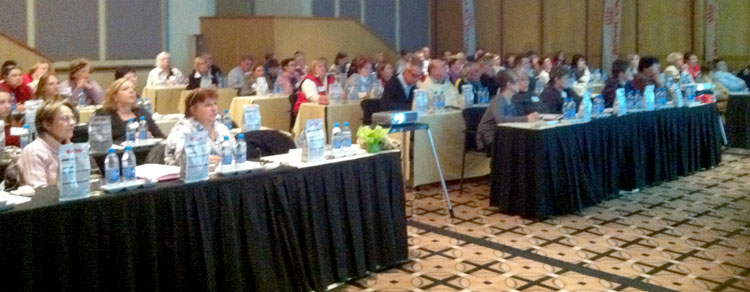
The delegates to the World Cat Congress. Front row, left to right: Chris Lowe (NZCF), Lesley Morgan Blythe (ACF), Penny Bydlinski (WCC Secretary/Treasurer), Pam DelaBar (retiring WCC President, CFA), Anneliese Hackmann (WCF), Cheryle U'Ren (CCCA). Second row, left to right: Jan van Rooyen (SACC), Eric Reijers (WCC President, FIFe), John Hansson (GCCF) and Vickie Fisher (TICA).
This year’s annual meeting of the World Cat Congress was a memorable one. The host member, the Southern African Cat Council (SACC), headed by its President, Mr Jan van Rooyen, were excellent hosts who appeared to have thought of everything. The whole weekend ran on oiled wheels from the moment the delegates were picked up at the airport to the final goodbyes.
The weekend’s activities all took place at the Grayston Hotel where the delegates were also accommodated; this arrangement always makes the proceedings a lot easier to administer and is also better for the delegates as they have the opportunity of socializing in the dining room and lounges.
The Seminar & Open Meeting took place on the Friday. The room was well equipped with two screens either side of the main platform, which was helpful as it allowed a clear view for those seated on either side of the room.
The delegates were first asked to introduce themselves, and each said a few words about the organisation they represented and, in some cases, their personal experiences in South Africa.

A view of the seminar.
The first speaker on a packed programme was Dr Daniela Steckler, a veterinary surgeon working in Natal. She was to talk on advances in the management of feline reproduction. She pointed out straightaway that compared to dogs, cats needed little help and generally cat breeders were better informed than dog breeders. She explained about several forms of birth control, giving the pros and cons of each; some of these were used regularly on big cats in the wild and some were not yet available for cats. She also referred to the use of a ‘teaser’ cat, which she did not recommend as it could lead to infection of the uterus. In explaining hormones, she said that more matings were better and matings carried out too early or too late in the oestrus cycle might not be successful. It was an interesting and informative lecture.
The next speaker was Dr Georgina Crewe, who in 2009 had been awarded a MSC for her work on treatment of specific carcinomas in the domestic cat. She was speaking on the use of megavoltage radiation in feline cancer patients. Dr Crewe explained a complicated subject in terms, which were easy to understand. Of particular interest and relevance in South Africa, and other sub-tropical climates, was skin cancer, which she explained very clearly, giving information on treatment and avoidance. Dr Crewe was an excellent speaker being both humorous and informative on a subject that was hitherto unknown to most of her audience.

Onlookers at the seminar.
The last item before lunch was on breeding programmes for African Wildlife. This was presented by the De Wildt Animal Sanctuary, which was a little way from Johannesburg. The centre was started forty years previously by Ann van Dyk who had seen that the species was endangered and difficult to breed in captivity, the female needing a lot of space and also to be able to select her mate. Ann had started in 1971 on her parents land with 10 cheetahs. In the meantime the sanctuary had bred 800 cubs. The sanctuary also supported the endangered African Wild Dog. There were less than 5000 left, 120 of which were in the Kruger. Other animals cared for were Anatolian Guard /dogs, Caracals, Jackals and also Leopards. We were told of the ‘King Cheetah’ of which there were less 100 in the world. These animals did not display the traditional spotted pattern but had instead a clear classic pattern, which is genetically recessive. This distinct pattern did not blend into the background in the same way as the spotted pattern and consequently few animals survived.

Stroking Byron.
The highlight of the day came when a fully grown live cheetah was led into the hall; obviously well used to the procedure, he jumped onto a raised dais and obligingly lay down and, being petted by his keeper, proceeded to purr, loudly. This was Byron, one of the ambassador cheetahs from the De Wildt Sanctuary. An ‘ambassador’ cheetah is used by the sanctuary for just that purpose. It is taken mainly to schools and similar institutions where young people can be taught about the cheetah and about the importance of the wild life to their country. Everybody was allowed to go and stroke his back; this was an exciting experience and it was with regret that we watched Byron being led out.
After lunch the programme continued with Dr Leslie Lyons, a speaker well known in the cat fancy and one who has addressed the WCC before. Her subject was updates on genetic testing and new breeds vs. defects. She spoke of the UC Davis cat domestication project, the feline genome and updated information on DNA testing. The latter subject was interesting, as she has shown there is no great diversity genetically between certain breeds. She also reported that the test for HCM had been withdrawn as it was not entirely accurate.
She spoke of breed control giving Korats as a positive example of this practice, She felt that in some breeds it would be advantageous if the breeding were to be limited; she gave an example in the American Burmese which is inbred and not genetically healthy. She said she believed in outcrossing and referred to her previously explained eight modern types of domestic cat, which she thought could be used in this way. It was an information packed lecture of great interest and Dr Lyons has a fine gift for imparting knowledge.
The last speaker of the day was Dr Victoria Geddes who discussed nutrition for reproduction and growth in cats. Dr Geddes is a South African vet who has practised in both South Africa and England and is now with Royal Canin concentrating on nutrition in dogs and cats. She updated us on the latest products from RC, each participant had received a sample bag, and spoke of the components necessary for cats healthy reproduction.

During the open meeting.
The open discussion followed the tea break. This is traditionally the time when the delegates are available to answer any questions which may be put to them. Among the subjects raised were judging qualifications and how in some organisations a person could become a judge in a few months and an all breed judge in two years. Some of the delegates spoke of the requirements of their own organisation, which took considerably longer. There was a long discussion about cats being exported without being tested for a disease that was known in the breed. Both GCCF and FIFe have mandatory tests for certain diseases in certain breeds. It was suggested that the WCC should develop recommendations for responsible management of genetic disease. The subject of contracts which buyers had to enter into when purchasing a cat was raised; in some cases these were restrictive and effectively reduced the gene pool in the breed. It was pointed out that legally these contracts were invalid but people were unwilling to put that to the test. The problem of reduction in gene pools was also not helped when an organisation required 8-generation pedigrees for registration. The delegate from GCCF said that they had an allowable outcross for all breeds. The discussions were lively and informative and ended the day’s proceedings on a pleasant note.
That evening SACC hosted a cocktail party for all the participants that gave us another excellent opportunity for further socialising before going on to another excellent dinner.
Saturday was the Winners Show of the SACC which also took place in the Grayston Hotel, The winning cats of the season competed for the final top awards and those delegates who were all breed judges were invited to officiate. This exciting event culminated in the Awards Banquet that evening when the winners were announced and the trophies presented. It was a fun evening with an excellent meal together with music and dancing.
On the Sunday the delegates were taken to a local Rhino and Lion Park where we were able to see Lions and Wild Dogs being fed as well as watching a baby Rhino playing behind its mother. There were also cheetahs and a display of the terrific speed of the cheetah. This was winter and not at all warm so, bundled up accordingly, we went on to a real South African braai, which is their word for a barbeque. This took place at the home of Thys and Jane Vermeulen, which is situated high above Johannesburg with a superb view of the valley below. Although we were very cold it was an enjoyable experience and an amazing example of South African hospitality.
On Monday the delegates gathered for the business meeting of the WCC at which Mr Eric Reijers who is general secretary of the FIFe and had been vice-president of the WCC for several years, was elected as the new WCC president.
The Minutes of the meeting are available for download.





